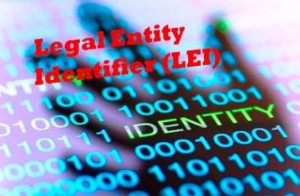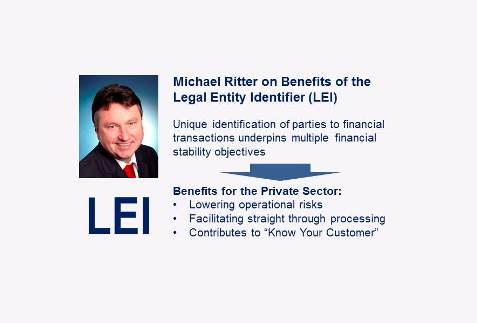 BIIA invited Michael Ritter to discuss the purpose of the Legal Entity Identifier (LEI) and its implications on business information. Michael Ritter is the Head of Central Credit Register at the Deutsche Bundesbank (Central Bank of Germany) and its representative in the Regulatory Oversight Committee (LEI ROC) of the GLEIS and furthermore represents Europe in the LEI ROC Executive Committee.
BIIA invited Michael Ritter to discuss the purpose of the Legal Entity Identifier (LEI) and its implications on business information. Michael Ritter is the Head of Central Credit Register at the Deutsche Bundesbank (Central Bank of Germany) and its representative in the Regulatory Oversight Committee (LEI ROC) of the GLEIS and furthermore represents Europe in the LEI ROC Executive Committee.
The Legal Entity Identifier (LEI) is a unique ID associated with a single corporate entity. The lack of a standard identification system for financial counterparties makes it difficult for financial firms to develop a consistent and integrated view of their exposures, such as in the case of default of counterparty. This is a challenge not only for firms, but also creates an obstacle for regulators to aggregate and share information to effectively monitor risks.
The Legal Entity Identifier was initiated by the Financial Stability Board to improve transparency in financial transactions. It was created without the involvement of the business information industry, which had for decades developed neutral identifiers for businesses. BIIA members asked Michael Ritter to explain the reasons behind the LEI and why the business information industry was not included from the beginning. Members also raised the questions: Will the LEI become a worldwide standard and will there be opportunities for the business information industry to participated in a meaningful way?
In a very detailed presentation Michael Ritter explained background and workings of the LEI organization, providing an update concerning progress made to date. He also answered the questions by BIIA members positively: The LEI will be a global standard. There is a requirement for businesses engaging in financial transactions to obtain a LEI and as such have to register disclosing their identity. This will provide transparency in cases were business registers are incomplete or deficient. Specific questions were asked in regards to ultimate parents of legal entities, the inclusion of branch offices and individuals acting in a business capacity.
Michael Ritter provided additional information concerning linkages to ultimate parents, branches and individuals engaged in business activities (see documents below).
To download Michael Ritter’s presentation please click on this link: BIIA`s 10 Anniversary 29 Oct LEI Ritter final
 BIIA encourages its members to work with the respective local LEI institutions in the interest of transparency and the development of accurate, reliable and timely business records.
BIIA encourages its members to work with the respective local LEI institutions in the interest of transparency and the development of accurate, reliable and timely business records.
Consultation document on collecting data on direct and ultimate parents of legal entities in the Global LEI System
This consultation document seeks input into the design of a process for collecting data on direct and ultimate parents of legal entities within the Global Legal Entity Identifier System (GLEIS).The main features of the proposal are:
- An incremental approach: this consultation document seeks to identify the priority features that should be part of the first phase of this data collection, with the objective of starting implementation around the end of 2015. Adding data on parent entities was envisaged in the 2012 FSB recommendations on the LEI and would augment the usefulness and attraction of the system for users. At the same time, the system is still at an early stage of development, with 385 000 entities worldwide having acquired an LEI, and the proposal seeks to avoid imposing unwarranted costs or complexities that could be detrimental to the expansion of the system. Relationship data can be expanded in future phases.
- Entities that have or acquire an LEI would report their “ultimate accounting consolidating parent”, defined as the highest level legal entity preparing consolidated financial statements, as well as their “direct accounting consolidating parent”. The identification of the consolidating entity would be based on the local accounting definition of control or consolidation applying to this entity.
- Accounting definitions were chosen as a starting point because (i) they are applicable to both financial and non-financial companies; (ii) their international comparability has increased, following greater convergence between IFRS and US GAAP on the scope of consolidation; and (iii) they are widely used, publicly available and their implementation is periodically reviewed by external auditors.
- The information collected would be published in the Global LEI System and therefore freely available for public authorities and market participants. It is envisaged at this stage to only record relationship data that could be made public.
- Entities would report to the Local Operating Units of the Global LEI System, which would verify the relationship information based on public documents if available (eg, list of subsidiaries in audited consolidated financial statements; regulatory filings), or other sources.
- Information on parents would be part of the information that must be provided in order for an LEI to be issued or renewed, but with the option to decline providing this information for reasons that would be made public. These reasons would include the absence of a parent which is eligible for an LEI, legal obstacles and cases where disclosure would be detrimental to the entity or its parents.
Answers to the attached questionnaire are invited to be sent to leiroc@bis.org by 19 October (BIIA has only recently obtained this document).
To download this statement click on this link: Consultation document on collecting data on direct and ultimate parents
Consultation document on including data on branches in the Global LEI System
The purpose of this document is to seek input from the public on the Regulatory Oversight Committee’s (ROC) proposed approach to incorporating data on branches into the Global LEI System (GLEIS). This approach is responsive to the mandate to make the GLEIS as open and inclusive as possible, and therefore more useful for both regulators and financial market participants, while also maintaining data integrity and upholding the founding principles of the GLEIS.
To download this statement click on this link: Consultation document on including data on branches
Statement on INDIVIDUALS ACTING IN A BUSINESS CAPACITY
Differences in the interpretation of the standards governing the Global LEI System (GLEIS) have been brought to the attention of the Regulatory Oversight Committee (ROC) concerning the eligibility to obtain an LEI by individuals acting in a business capacity. This statement is intended to provide clarity to the GLEIF, (pre-)LOUs1 and LEI registrants in order to improve consistent application among LOUs regarding registrant eligibility for LEIs.
To download this statement click on this link: Statement on individuals
Additional useful links: http://www.leiroc.org/ – https://www.gleif.org/en
This information was provided courtesy of Michael Ritter, Head of Central Credit Register Deutsche Bundesbank Zentralbereich Banken und Finanzaufsicht and member of various LEI executive committees.























Trackbacks/Pingbacks